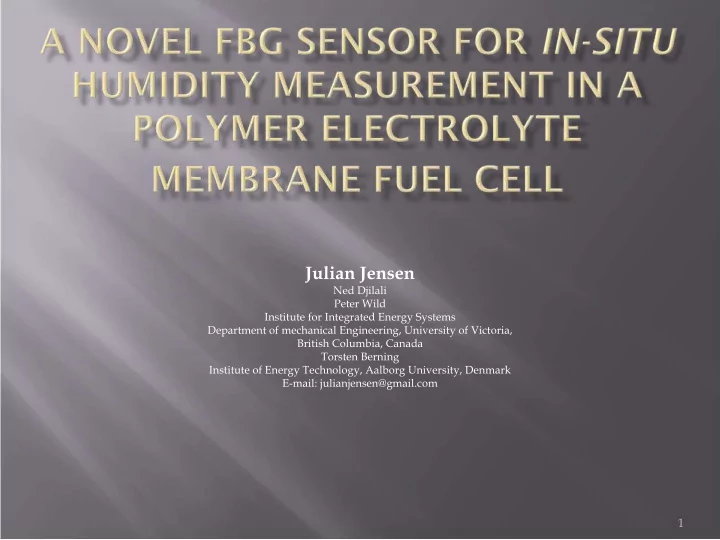

Julian Jensen Ned Djilali Peter Wild Institute for Integrated Energy Systems Department of mechanical Engineering, University of Victoria, British Columbia, Canada Torsten Berning Institute of Energy Technology, Aalborg University, Denmark E-mail: julianjensen@gmail.com 1
Project description Water in a Fuel Cell FBG sensing principle Sensor fabrication Sensor calibration Results Future work 2
Working on it for four months Utilizing a lot of knowledge obtained by Prof. Peter Wilds FBG-group Using the FC-test station with help from Ph.D. student Nigel David who will continue my work and improve the design 3
Now: can measure in –and outlet RH No in-situ measurements Conventional sensors are too big No way of knowing when the air saturates in the FC Too wet flooding blocking of pores in GDL or electrodes Too dry loss of proton conductivity 4
Exit air RH, Inlet is λ =1.5 λ =2 λ =3 λ =6 λ =12 λ =24 Temp ( ° C) 20 ° C and RH is 70% 20 213 142 If FC is operated 30 194 117 78 above 60 ° C, external 40 273 195 112 68 45 humidification is 50 208 164 118 67 40 26 needed 60 129 101 72 41 Difficult to control 70 82 65 46 RH and flooding 80 54 43 30 occurs easily when 90 37 28 no feed-back Larmine & Dicks, Fuel Cell Systems Explained 5
A FBG is written into the • core of the fibre using UV-laser. This induces a periodic • modulation of the core refractive index Only one WL is reflected, • the Bragg WL When fibre is strained, • the Bragg WL shifts Possibility of • multiplexing 100s of sensors on one fibre 6
Thin coating fast response time but low sensitivity Trade-off Compensated for by etching fibre from 125 µm to 37 µm, reduces tuning force by a factor of 10 7
COATING STEPS FROM COATING SET-UP LITERATURE Chose “Expensive” polyimide Take off existing polyimide 1. 2. Clean with isopropanol 3. Coat with adhesion promoter 4. Cure 5. Coat with Polyimide, multiple layers 6. Cure 7. DONE! 8
Sealed chamber Commercial RH sensor RH +-~2% ASTM 104 standard Salt RH @ 20°C K 2 Co 3 43.2±04 FBG sensor NaBr 59.1±0.5 KI 69.9±0.3 Saturated salt solution RH +- 1% NaCl 75.5±0.2 KCl 85.1±0.3 K 2 SO 4 97.6±0.6 9
Fibre is more than 10 times more sensitive to T than RH Dry air (<2% RH) Heated to 90 ° C and cooled 10
11
12
43-85%: 8s increasing RH, 14s decreasing 43-98%: 9s increasing RH, 14s decreasing (t 90 ) Compared to literature: 18 min 13
• No air flow • ~12%RH air through hum. RT • Humidifier 40 ° C • ~12%RH 14
Sensor @ outlet 0-3300s: <2% RH air 3300: 12%RH air Long start-up Slow humidification 15
Coating recipe New fixture updated Calibrate for more 9s response-time RHs 0.65 pm/%RH Calibrate in constant temperature 10.9 pm/ ° C Compare models to Good repeatability measurements Multiplexing Smaller FBG $32,350 from Vytran 16
Thank you for your attention 17
Recommend
More recommend